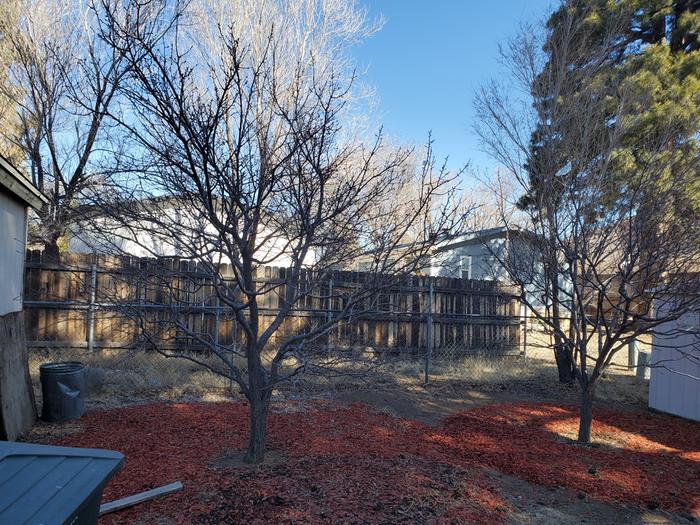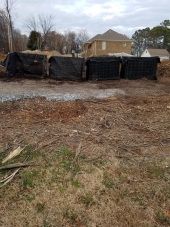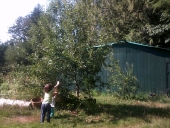
 1
1





“The best of all is 'God Is With Us'!”
-John Wesley
 1
1




Other people may reject you but if you lie in the forest floor for long enough the moss and fungi will accept you as one of their own!




Dennis Bangham wrote:"how to build" your own
“The best of all is 'God Is With Us'!”
-John Wesley




Dennis Bangham wrote:Look in Dr. Redhawks soil series. He has "how to build" your own in there.
Bryant RedHawk wrote:Now we know that to get the best out of our plants we should make sure that the soil we grow them in should be biology rich but that there is an optimal ratio for each family of plants.
What this means to us the gardener or farmer is that we don't always want to have an equilibrium of types of organisms present everywhere in our gardens.
We also know that getting organic materials down into the soil is the base for building the microorganisms in the soil.
We know too that compost is our best material for both growing our organisms and getting the organic material base.
With these bits of knowledge in mind, we then can make good decisions on which to use at any particular time during our soil building phase.
If we have a very porous soil that water runs through quickly, we know that we need to add lots of organic material deep into the soil to increase the water holding ability.
This means we should lay down a fairly thick layer of compost (3" minimum usually) and then do that one tilling, going as deep as we can to get the organic material deep into the soil where it won't vanish in a year or two.
For many this seems to be counter productive since we are going to do a disturbance that we have learned kills our microorganisms, but this is a one time only use of tillage, we are never going to do it again.
Since we are using good compost for that tilling in of organic material, we are actually adding life deep into the soil, this gives our next steps a solid foundation which means they will actually perform better than if we didn't do that one time tilling.
If we have compacted soil, this becomes even more important to do since we need to break that impenetrable layer and at the same time get our organic material mixed in at least as deep as the compacted layer.
Once again this is a one time only affair and we want to get as much organic material down there as possible so we have that good foundation deep in the soil.
By doing this we have not only broken the compacted layer so water can get past it but we have also added lots of microorganisms down there so the compacted soil will continue to break up and become that fluffy, water holding stuff we really want.
If we can't get the equipment in to the area we know we need to treat this way we do have an option and that is water born injection of compost or compost tea/ extract.
What we do for this injection method is acquire by either rental or construction an injection device. (I will give a description of how to build your own, sadly I don't have the capability of adding photos but do hope to eventually be able to do that)
The injector syphons our compost tea into the water stream and thusly pushes our microorganisms down into the soil where they will be able to spread as they multiply out approximately 2.5 feet from the point of injection.
This means we can sink our injector every 5 feet in a grid pattern and end up with almost the same effect as if we had tilled.
The only draw back to using the injector method is that you have to do this twice the first year, but the second time you don't have to use a 5 foot grid, you can go further apart if you want to.
An Injector is usually made of metal pipe (commercial ones are either aluminum or galvanized steel) Rigid copper pipe also works and is usually easier for the do it yourself builder.
1/2 inch rigid copper for the pipe works pretty well and is far less expensive than 1 inch copper pipe, the lever valve and other fittings are also less expensive and you will use less non-lead solder to put the apparatus together.
The injector needs to be long enough that you can have the option of sinking it 5 feet deep into the soil.
Mine is home built and 7 feet long from tip to water hose attachment.
These are the parts you will need; 1 length of 1/2 inch rigid copper pipe, one solder on lever type ball valve, one 1/2 inch T solder on fitting with the 1/2 inch on the ends and a 1/4 inch center size, 1 1/4 inch hose bib to attach the syphon hose too the apparatus, 10 feet of 1/4 inch poly hose,
1 solder on garden hose female fitting for attaching your hose to the top end of the apparatus. You will also need a copper pipe cutter, pair of slip joint pliers or hammer and anvil, propane torch for soldering, soldering flux.
When I built mine I purchased a 10 foot piece of rigid copper pipe the left over piece became a soil sampler.
To assemble you first cut the main pipe to the length you want minus about a foot. the next step involves flattening one end of this main pipe so it will give off a jet of water (use a hammer and solid surface to start the flattening then crimp in the middle with the slip joint pliers)
Next you want to install the valve and above that a short section of pipe for fastening the T, then another short piece of the main pipe and last is the garden hose fitting. If you want to be able to have the syphon hose not spew water when you have the main valve off, you need to add a 1/4" valve before the hose bib.
This thing will drill a hole as deep as you can push the main pipe down into the soil very quickly. Once you have the hole drilled turn on the 1/4 inch valve to suck your compost tea down into the hole and out into the surrounding soil, leave this valve on as you withdraw the pipe, shutting it off just before you remove the water injector from the hole. Move 5 feet and repeat, do this until you have the area you are treating completely covered.
Being fairly sure I've done a bad job of trying to explain this apparatus, if I'm asked for better instructions, I'll try again.
When I am working on improving the soil on my farm I first map out what I'm going to be growing in that particular area, then I drive my soil sampler in, taking a sample core about every 5 feet in a grid pattern.
I lay these cores out for visual inspection to determine the current soil condition after which comes slide making and microscope work.
These steps let me determine the issues I need to address so I can decide the best next step, which is amendment for microorganism proliferation.
Currently I am brewing a batch of compost tea that will give me equal amounts of bacteria and fungi because I am working on a new Silvo-pasture area of about 2 acres.
and I'll be back with more
Redhawk
“The best of all is 'God Is With Us'!”
-John Wesley
 3
3




The best way to "speed up tree growth" is to make sure there are mycorrhizae on and inside the root system, you can do this by inoculating the area from just inside the drip line to about 2 feet beyond the drip line.
I have an "Injector" but you can even use a simple piece of pipe driven into the soil about a foot to two feet deep then pour some mycorrhizal inoculant into the resulting hole, do this at least every four feet measured along the circumference (drip line circle) and you will have enough to increase the nutrients to levels that increase the growth rate of the tree.
Invasive plants are Earth's way of insisting we notice her medicines. Stephen Herrod Buhner
Everyone learns what works by learning what doesn't work. Stephen Herrod Buhner

|
After three months of being pooless the hair and skin on this tiny ad is glorious!
A rocket mass heater is the most sustainable way to heat a conventional home
http://woodheat.net
|



